Gourd Charms

Gourds in Ancient China
In China, the calabash, or "bottle-gourd" plant, has long been used as a food and medicine, and its hard shell as a bottle, a dipper and even an ancient musical instrument. Gourds have traditionally been used to carry medicine, wine and "magic" elixirs. Gourds were also tied to the backs of children and boat people to serve as life preservers.
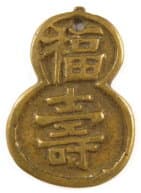
The Chinese have a strong propensity to associate similar sounding words. For example, trailing gourd vines are described in Chinese as man (蔓). This same character can also be pronounced as wan and has the exact same pronunciation and meaning as 万 which means "10,000".
Because the gourd contains many seeds, the Chinese associate the gourd with "10,000 children". In ancient China, parents hoped for many sons and grandsons so the gourd became an important charm symbol for a large family with many children.
The gourd is popular as a charm to ward off evil spirits and disease because its first character (hu lu 葫芦) has the same pronunciation as the word to "protect" or "guard" (hu 护) and also the word for "blessing" (hu 祜).
The Chinese word for gourd, hulu (葫芦), has other auspicious associations as well. In some dialects, the character hu (葫) has a similar pronunciation to fu (福) which means "happiness" or "good fortune". Therefore, saying hulu (葫芦) for gourd would sound similar to fulu (福禄) which means "happiness and rank" (as in attaining a high government office).
The Chinese consider the number "8" to be very auspicious and an omen for good luck (see Hidden Meaning of Symbols). The gourd, as the gourd charm above illustrates, resembles the number "8".
The gourd was considered to have a magical power to protect Chinese children from smallpox. The custom was for parents, on the last night of the year, to hang a gourd shell near where a child who had not yet had smallpox slept. It was believed that the god of smallpox and measles would "empty" the smallpox into the gourd shell instead of the child if there was one nearby. Should the child happen to come down with smallpox in the future, it was believed that the illness would be less severe if the parents followed this custom.
Also, in ancient times, old men would frequently be seen carrying gourds on their backs. Gourds, therefore, gradually became associated with old age and charms, such as the one pictured below, took on the gourd-shape to signify longevity.
The Myth of Hundun (Hun Tun) the Cosmic Gourd
One of China's earliest myths was first recorded in the late Zhou (Chou) dynasty (1046 BC-256 BC) in such works as Zhuangzi (Chuang Tzu 庄子) and "The Classic of Mountains and Seas" (shanhaijing 山海经). (Please see peach charms for another story from "The Classic of Mountains and Seas" concerning "door gods" and peach wood amulets.)
Hundun (混沌) is described as a god of primordal substance without any apertures or holes. In some accounts he is referred to as the cosmic gourd in that he is irregularly shaped and contains the seeds that symbolize the creative potential of the primary and undifferentiated Dao (Tao 道).
In the story, Hundun is the god of the center. The god of the south (Shu) and the god of the north (Hu) frequently came to visit Hundun who always treated them very cordially. Shu and Hu wanted to repay Hundun's generosity. They said, "All humans have seven openings to see, hear, eat and breathe. Only this one (referring to Hundun) has not got any". So, on each day they chiseled one opening in Hundun. On the seventh day, Hundun died.
The story can be interpreted in several ways. One interpretation illustrates that the gods Shu and Hu did not act "spontaneously" or with "noninterference" and therefore did not follow the Dao. They were more concerned with proper protocol such as gift-giving. They had a human-oriented bias in that their response was to give Hundun human orifices so that he would have the "prestige" of a human face. They did not act with natural and spontaneous actions in accordance with the core Daoist (Taoist) philosophy of wuwei (wu-wei 无为) which demands that one submit to and move with, as opposed to against, the natural processes and change. As a result of their actions, Hundun died.
The Gourd as a Daoist (Taoist) Symbol
In Daoism (Taoism), the gourd shape is taken to represent heaven and earth with an extended meaning representing the entire universe.
Within the gourd there is a mystical zone in the form of an alternate universe or the entrance to another world, and Daoist immortals and practitioners can travel between these two worlds.
Because of this association, the bottle gourd has long been a Chinese symbol of self-containment and self-sufficiency. Old Chinese fables sometime describe a person accidentally coming upon a small, narrow opening in the mountains and entering into a mystical or fairy world where people enjoy peace and long and happy lives.
This same physical characteristic of the gourd carries over into the traditional Chinese garden where a person enters an enclosed but spacious compound through a small opening or gate.
The gourd is also the Taoist (Daoist) symbol of alchemy. It was believed that the "elixir of immortality" could be produced through the distilling of red cinnabar placed in the upper chamber of the gourd and mercury placed in the lower chamber. The "marriage" of these two substances was a sexual metaphor for the union of semen and menstrual blood to create life.
The Gourd as a Symbol of Li Tie Guai
The gourd is also the symbol of Li Tie Guai (Li Tieguai 李铁拐) who is known as "Li with the Iron Crutch" and is one of the Eight Daoist (Taoist) Immortals (八仙).
The story is told that one day Li left his body in order to visit Laozi 老子 (the founder of Taoism) on the sacred mountain of Hua Shan (花山). Before departing, he instructed one of his disciples to guard his body during his absence. The disciple was further instructed that if he did not return within seven days, he was to burn the body. On the sixth day, however, the disciple received word that his mother was dying. Being a filial son, the disciple quickly returned home but not before burning Li's body.
Li returned after seven days only to find his body in ashes. He was forced to enter the only body that was readily available which was that of a dead crippled beggar. He turned the beggar's bamboo cane into an "iron crutch" which also became a magic staff that could transmute matter. Li was also able to magically make the "elixir of immortality" in the gourd which he carried.
Li used the magic elixir from the gourd to bring the disciple's mother back to life.
Li also had the ability to make himself so tiny that he could sleep inside the gourd.
The Gourd as Symbol for the Yellow River, Dragon Veins and the Womb
The gourd is actually a multifaceted symbol in China.
Ancient Chinese maps show the source of the Yellow River as bottle-gourd shaped.
In fengshui (风水), the origins of the major "dragon veins" (the pathways through which energy flows over mountains) are also depicted as gourd-shaped.
(For a detailed discussion of feng shui and Chinese coins, please see Feng Shui Coins.)
Because of its shape, gourds also symbolize the "womb" in both the sense of the female reproductive organ as well as in a broader creative sense.
The Magic Gourd, the Monkey King and the "Journey to the West"
The gourd has also played a role in popular Chinese culture. The "Journey to the West" (xiyouji 西游记) is one of the most famous novels from the Ming dynasty (1368-1644) and one of the most beloved characters from that novel is the Monkey King (Sun Wukong 孙悟空).
In one episode, the Monkey King receives word that demons are on their way to capture him with their magic gourd. The Monkey King disguises himself as an immortal and goes to meet them. The demons are unaware that the immortal is, in fact, the Monkey King and proceed to show him the magic gourd which can hold ten thousand people. The Monkey King then shows them a gourd, which in reality is perfectly ordinary, but which he says is magical and can hold the entire universe.
The demons are intrigued and express willingness to swap their magic gourd for the immortal's gourd if he can prove that it indeed has the power to contain the sky.
The Monkey King, who has many extraordinary abilities, quickly obtains permission from the spirits to block the light of the sun, moon and stars for one hour.
The Monkey King is thus able to deceive the demons into thinking that he has bottled up the heavens in his gourd and, in so doing, is triumphant in swapping his ordinary gourd for the demons' magic one.
Gourd Charms
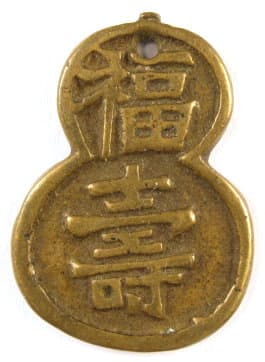
"Happiness and Longevity"
Inscription
This is an example of an old gourd charm that has the
Chinese characters fu (福) and shou (寿) on its obverse side.
Fu means "happiness" and shou means "longevity".
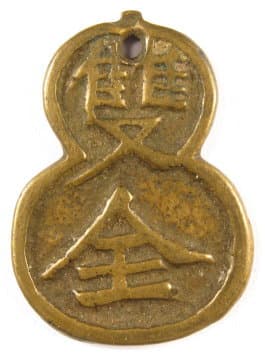
Charm with "Both Complete"
Inscription
The reverse side of this gourd charm has the Chinese characters shuang (双) and quan (全).
Shuang means "both" and quan means "complete".
The charm's entire inscription therefore reads "Happiness and Longevity both complete".
The charm measures 41 mm in length and 29 mm in width. It weighs 15.8 grams.
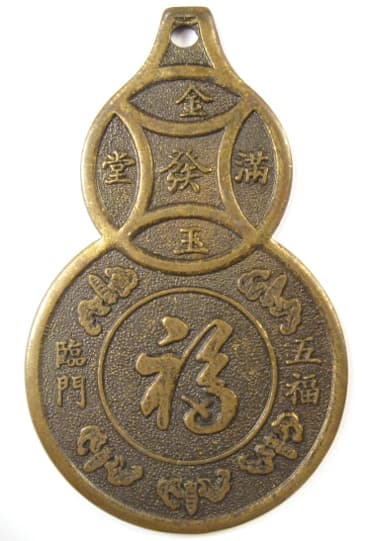
representing "Five Blessings",
"Five Happinesses" or
"Five Good Fortunes"
The upper part of the charm resembles an old Chinese cash coin. It is round with a square box in the middle to signify the "square hole" of a real coin. The shape of a Chinese coin, of course, is an obvious symbol of prosperity and wealth.
The Chinese character in the middle of the "square hole" is fa (发) which means "to issue" and here can be interpreted to mean facai (发财) "to make a fortune".
The four character inscription just inside the rim of the "coin" is read top to bottom and right to left as jin yu man tang (金玉满堂). This is a very common charm inscription for prosperity and means "may gold and jade fill your halls".
The lower portion of the charm has a large fu (福) character in the middle meaning "good fortune".
Surrounding the character fu (福) are five flying bats. A bat (fu 蝠) is a visual pun for "good fortune" or happiness (fu 福) because both characters are pronounced the same.
The bats at the top are shown flying upside down. In Chinese, the character dao (倒) for "upside-down" and the character dao (到) meaning "to have arrived" are pronounced the same. If you say "the bat is flying upside down" a listener could just as easily interpret this as "happiness has arrived".
The depiction of "five bats" is a traditional representation of what is known as the "Five Blessings", also known as the "Five Happinesses" or "Five Good Fortunes". These five blessings refer to longevity (寿), wealth (富), health and composure (康宁), virtue (修好德), and the desire to die a natural death in old age (考终命). (Another "five bat" charm representing the "five fortunes surround longevity" (wu fu peng shou (五福捧寿) may be seen at Chinese House.)
The wish for good fortune is further reflected in the Chinese four character inscription located at the three o'clock and nine o'clock position. The inscription reads wu fu lin men (五福临门) which means "may the five fortunes arrive at your door".
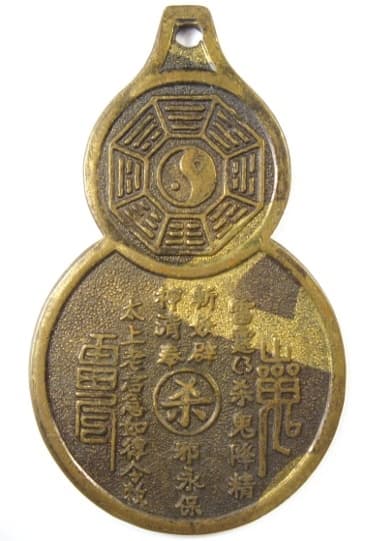
displaying Daoist (Taoist)
magic writing, bagua and taiji
At the top is the bagua (八卦) which is the eight combinations of trigrams. For more information on the bagua or eight trigrams please see The Book of Changes and Bagua Charms.
In the center of the bagua is the yin yang (阴阳) or taiji (太极) symbol.
The lower part of the charm includes two large "Daoist magic writing" (fuwen 符文) characters which translate as the "God of Thunder orders the demons to be killed".
There is also an inscription in Chinese:
雷走杀鬼降精 (lei zou sha gui jiang jing)
斩妖出邪永保 (zhan yao chu xie yong bao)
神情奉 (shen qing feng)
太上老君急汲之令 (tai shang lao jun ji ji zhi ling)
"God of Thunder (Lei) clear out and kill the ghosts and send down purity.
Behead the demons, expel the evil and keep us eternally safe.
Let this command from Lao Zi (Tai Shang Lao Jun) be executed quickly."
The Chinese character in the center of the charm with the circle around it is sha (杀) which means "kill".
Please visit Daoist (Taoist) Charms for a more detailed discussion of Daoist magic writing and this specific Chinese inscription.
This charm is 63.5 mm in length and has a maximum width of 39 mm. It weighs 27.4 grams.
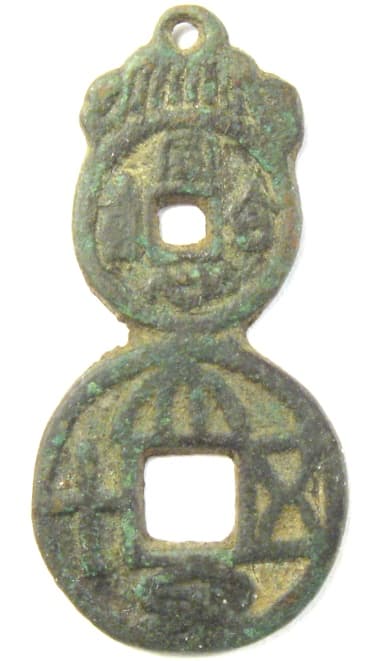
at the top being
"tong xin he yi" meaning
"to be of one mind"
The gourd-shaped charm at the left is based on the easily recognized ancient Chinese cash coin as a symbol of wealth and prosperity.
The charm resembles two round cash coins with square holes in the middle stacked one above the other. Both "coins" have four character inscriptions just like real cash coins.
However, this is a charm and the inscription on the top "coin" is different from what would be found on a coin.
The inscription is read top to bottom and right to left as tong xin he yi (同心合意) which translates as "to be of one mind".
On the other hand, the "coin" on the bottom very closely resembles an actual coin cast during the years 7-14 AD of the reign of Wang Mang of the Xin Dynasty. The inscription reads da quan wu shi (大泉五十) which means "large coin fifty". At the time, one of these coins was valued as equal to 50 of the Han dynasty wu zhu (五铢)coins.
In the centuries that followed, the da quan wu shi coin became popular as the basis for charms.
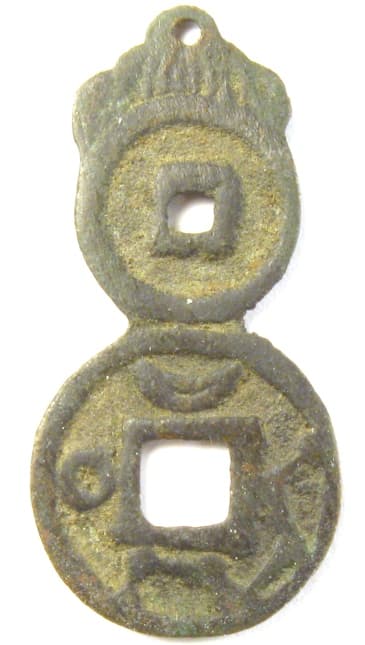
the sun, moon and Big Dipper
This is the reverse side of the charm.
The upper coin has no Chinese characters or symbols and looks just like the back of many old Chinese coins.
The bottom da quan wu shi coin, however, displays several symbols.
Above the square hole is a crescent moon.
To the left of the hole is a circle representing the sun.
At the right and extending to below the square hole are seven dots connected by a zigzag line symbolizing the Big Dipper star constellation.
The Big Dipper or "Ladle" constellation symbol is found not only on charms but old Chinese swords as well.
The sun, moon and Big Dipper are fundamental Chinese symbols representing "light". The sun also represents the male principle of yang while the moon represents the female principle of yin.
This charm probably dates from the Song Dynasty (960-1279) or Yuan Dynasty (1271-1368) and is actually very small. The length is 36 mm and the width is 17 mm. The weight is 2.9 grams.
Return to Ancient Chinese Charms and Coins
